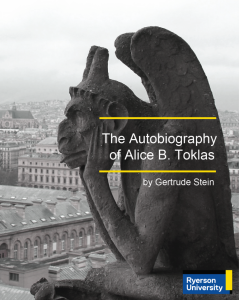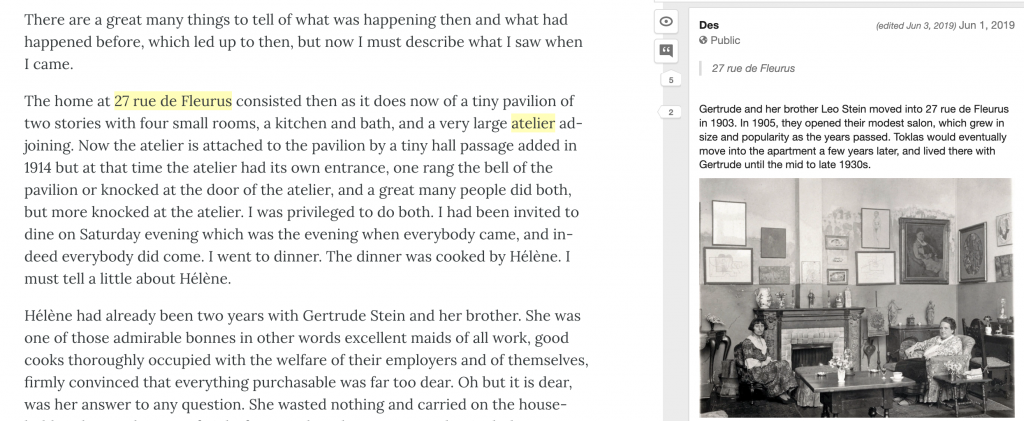Building on the Public Domain: Open Pedagogy
One of the key components of open pedagogy is the use of non-disposal assignments, student work that is publicly available on the Internet which lives on beyond the end of the course for others to read and reuse, and enhance. Two main tools used in open pedagogy that we will mention here are the social notes annotation tool Hypothes.is and Wikiedu. In addition to these specific tools, students can interact with the public domain texts directly by writing introductions that can be used and reused by others. Other Open Pedagogy ideas including using zines in the classroom, students writing their own exams and questions, and creating shared annotated bibliographies can be used when teaching from the Public Domain Core Collection.
Wikipedia: Canadian Examples
In his essay Open Pedagogy: The Time is Now – Beyond The Lecture: Innovations in Teaching Canadian History, Thomas Peace shares that he used Wikipedia in his effort to practice open pedagogy in his course HIS 2204G: Crises and Confederation in 2018. Having been inspired by others using open pedagogy he shares that he found the Wikipedia assignments to be a success. As well as actually annotating Wikipedia records, he combined the assignments with the creation of posters which he posted on his teaching blog. Pages that his students added or annotated included the Black Power movement in Montreal – Wikipedia and The Quebec Conference, 1864. Some of the titles and authors in the Public Domain Core Collection do not have Wikipedia pages or have pages that are not expansive. This creates opportunities for students to help research and improve the quality and breadth of Wikipedia coverage.
As of February 2022, Wikipedia has had over 5,177,317,904 page views, so it is a widely used resource by the public worldwide. The value of Wikipedia assignments can be to improve the quality of public knowledge. In 2008, for example, the SPAN312 (“Murder, Madness, and Mayhem: Latin American Literature in Translation” course at UBC decided to use Wikipedia with the challenge to “improve Wikipedia’s coverage of selected articles on Latin American literature, particularly those related to dictator novels,” submit the revised article to Wikipedia peer-review, and increase the number of featured articles in this area. Wikipedia does have an internal ranking system of peer review for articles called “featured articles” articles which they use as models of “accuracy, neutrality, completeness, and style” for the platform and which have criteria on which they are evaluated. The SPAN312 class ended up with three featured articles, and eight articles that were ranked “good” by Wikipedia evaluators. As well historically marginalized communities may not be well represented in Wikipedia, so assignments can be used to improve diversity in Wikipedia articles,
In Madeline Knickerbocker’s FNST/HIST 325: History of Aboriginal Peoples of North America to 1850 class at Simon Fraser University, she had students add between 700 and 1000 words to Wikipedia articles that were sparse on Indigenous history. The instructor made sure that students had access to Gregory Younging’s Elements of Indigenous Style to make sure that they were using sensitive and appropriate language to write about Indigenous peoples. The goal of the assignment was to provide accurate representations of Indigenous peoples and their pasts. If you would like to read her Wikipedia Project assignment it is publicly posted. One aspect that the Wikipedia editing project uncovered, which ultimately strengthened a particular article and created a learning opportunity in the classroom, was the interaction between an Indigenous Wikipedia contributor and students working with the historical record. In one case a student had unintentionally deleted a photo and a contribution by an Indigenous Elder. The dialogue that developed between the Indigenous contributor and the student was challenging but created a richer and more respectful understanding of how to work with Indigenous Knowledge. Ultimately, the student contributor and the Indigenous contributor came to an understanding of how to go forward with the editing process of that article, with more respect given to the Indigenous perspectives and the role of Elders.
Annotating Alice: Hypothes.is andThe Autobiography of Alice B. Toklas
 Students and scholars have a long tradition of annotating print materials in the course of their studies. With the advent of the web, annotation has the potential to become a more collaborative and social activity. Web annotating tools such as Hypothes.is open up a wide range of possibilities for engaging students with web-based texts and for providing them with an avenue for contributing their research and commentary to the discourse related to those texts.
Students and scholars have a long tradition of annotating print materials in the course of their studies. With the advent of the web, annotation has the potential to become a more collaborative and social activity. Web annotating tools such as Hypothes.is open up a wide range of possibilities for engaging students with web-based texts and for providing them with an avenue for contributing their research and commentary to the discourse related to those texts.
In the spring semester of 2019, Ryerson University sessional instructor Dr. Melissa Tanti created a Hypothes.is annotation assignment for the students in her Introduction to Nonfiction course. Her intent was to encourage engagement with one of the texts, The Autobiography of Alice B. Toklas, that she had assigned.
Because this work is in the public domain in Canada, a copy of it was made available on the University’s Pressbooks publishing platform. All the students in the course had access to the same version of the text at no cost. Although web annotation can be used in a variety of different ways, this work lends itself well to “annotation as gloss” as it mentions many individuals, works of art, places and historical events. Students worked in pairs to annotate each chapter with text, images and links. In this way they built a layer of additional information over the text. As each pair of students completed the annotation of their chapter, they made a presentation to the rest of the class based on the contents of their annotations. In this way the class worked through the entire contents of the book together, learning from one another during the presentations in class and from reading one another’s annotations.
The students were unfamiliar with web annotation; they reported that it was a new experience and that they learned a lot from it. They particularly enjoyed the sleuthing aspect of the assignment and were intrigued to find out that something that seemed to be a trivial comment in the text, turned out to be a reference to a significant historical event that was previously unknown to them. The students were keen annotators to such an extent that the instructor indicated that in future assignments she would provide additional guidance as to the length and number of annotations to keep discussions concise and relevant.
The instructor found that having the students annotating and presenting on various chapters was a good way to work through the text. She said that in previous courses she never really had a clear idea as to how much of the readings students were doing; however, in this case, she was more confident in knowing what they had read. She found that the annotation assignment was a creative way to encourage close reading and it fostered peer-to-peer learning as the students read each others annotations.

Although this course was taught more that two years ago, the students’ annotations continue to live on long after the completion of the course. They can still be viewed on the web where they contribute to the body of knowledge associated with this text.
Wikipedia and Hypothes.is are just two ways that you can encourage your students to make contributions to resources that are accessible on the internet.
Sources:
Thomas Pearce, Open Pedagogy: The Time is Now – Beyond The Lecture: Innovations in Teaching Canadian History, in Eidinger, Andrea and McCracken, Krista. Eds. Beyond the Lecture: Innovations in Teaching Canadian History. Active History, 2019. is licensed under a Creative Commons Attribution-ShareAlike 4.0 International License, except where otherwise noted. (The material was used for reference not reused or remixed).
Jon Beasley-Murray, March 14, 2018, Murder, Madness, and Mayhem, Open Pedagogy Notebook. Open Pedagogy Notebook is licensed under a Creative Commons Attribution 4.0 International license unless otherwise noted.

